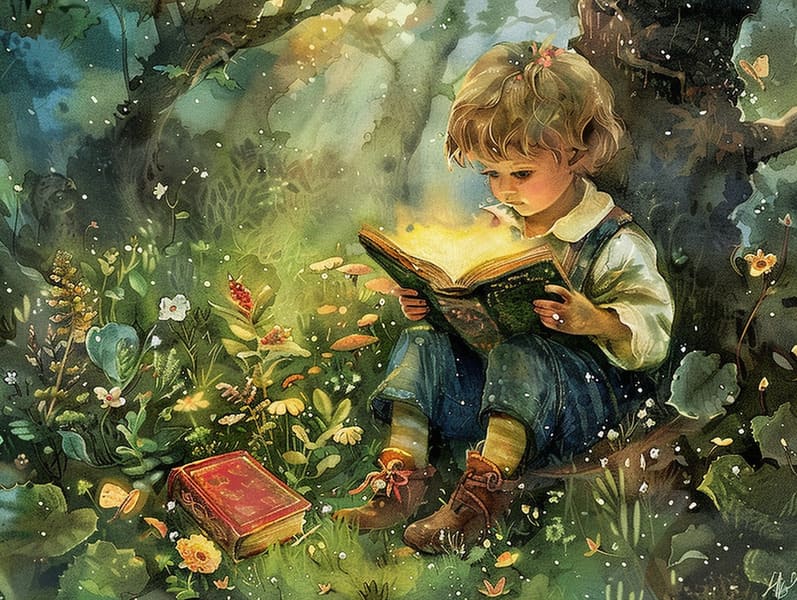The Inception of Fairy Tales for Kids with the Unceasing Delight.

Famous fairy tales have old origins. These narratives have been whispered from one generation to the next far before they were ever transcribed. They arose from a variety of societies, including Eastern traditions. They were initially disseminated among adults, often carrying themes and messages aligned with the societal norms and beliefs of the time.
The Grimm brothers, Jacob and Wilhelm Grimm, were among the first to compile many of these beloved narratives. Their anthology, "Grimm's Fables," included classics like "Cinder Maid," "Hansel and Grethel," and "Snow-White and Rose-Red," which have since become pillars in the world of iconic fairy tales. Similarly, Hans Christian Andersen's delightful tales, such as "The Mermaid's Tale," and "The Duckling that Could," have gained the love worldwide, guaranteeing their place in the pantheon of iconic fairy tales.
Despite their historical roots, traditional fairy tales remain as impactful as ever, especially as children's night stories. These enchanting tales are now available in numerous formats, including beautifully illustrated books, enchanting animations, and free fairy tales online.
Their unwavering allure can be traced to several magical reasons:
Ethical Lessons: Classic fairy tales often convey important moral lessons. Narratives like "The Tale of the Boy Who Cried Wolf" teach the merit of sincerity, while "The Hare and the Tortoise" underline the qualities of determination and humbleness. These tales offer kids clear distinctions between truth and falsehood, forming their moral compass in a gentle yet important way.
Sympathy and Perception: Timeless fairy tales frequently present heroines facing struggles and tests, prompting listeners to identify with their struggles and encourage their triumphs. For instance, "Beauty and Her Beast" shows us the virtue of looking beyond appearances to comprehend the real person of a person, advancing compassion and knowledge.
Cultural Perception: Many old fairy tales are rooted in the cultural contexts from which they sprang. Exploring these tales can provide informative snapshots into different historical contexts, strengthening a sense of cultural awareness and appreciation.
Inventiveness and Fantasy: The supernatural elements in fairy tales—talking beasts—boost children’s visions and dreams. These fairy tales transport readers to fantasy realms, engendering innovative dreams and a sense of amazement that stays a lifetime.
Classic fairy read more tales are not only delightful but also teaching. They act as fantastical tools in promoting various mental and emotional abilities in young readers. When classic fairy tales are narrated, they develop speech development by introducing new word meanings and complicated sentence structures. This practice also boosts auditory skills and attention span, as children pay close attention, excited to see what happens next.
Furthermore, contemplating the themes and characters of old fairy tales can cultivate logical thinking and analytical skills. Little ones are led to spot patterns, predict happenings, and understand cause and effect. These analyses also boost the young convey their thoughts and feelings, enhancing their emotional intelligence.
In today’s modern era, the availability of digital fairy tales has made these tales more within reach than ever. Web-based platforms and software provide comprehensive collections of old fairy tales that can be experienced or listened on anytime, anywhere. Fairy tales read aloud are particularly popular, presenting an engaging way for little ones to experience these captivating stories. Voice books and narrated videos lead characters and settings to life, often augmented by spellbinding musical scores and music that elevate the tale journey.
The lasting appeal of timeless fairy tales lies in their ability to alter to the present while continuing with their central messages. Contemporary reinterpretations of these stories often show more diverse protagonists and modern settings, making them accessible to today’s audience. However, the main ideas of gallantry, understanding, and even-handedness remain unchanged, continuing to appeal to children of all ages.
Timeless fairy tales also offer a sense of serenity and recognition. They provide a organized narrative with a definite beginning, middle, and end, often coming to a close with the resolution of conflicts and the triumph of goodness over badness. This consistency can be reassuring for children, providing a sense of firmness in an shifting world.
Traditional fairy tales continue to enthrall and inform new generations, maintaining their captivation and pertinence in modern society. As bedtime stories for kids, they impart a perfect blend of enchantment and education, supporting moral values, empathy, and creativity. The proliferation of free fairy tales online and the sought after status of fairy tales narrated make sure that these old narratives remain accessible to new generations.
By retaining and passing on these narratives, we continue to revere the rich tapestry of fantasy and cultural heritage. Whether you are reading a beautifully illustrated book, perusing a internet collection, or listening through an narrated book, the charm of ancient fairy tales is always within reach. These tales show us of the unfading force of narratives and its ability to unite us across generations and cultures.
Be it you are accessing a vibrantly illustrated book, exploring a electronic library, or listening on an voice book, the allure of classic fairy tales is always within reach.
These fairy tales demonstrate of the consistent effect of stories and its ability to bring us together across eras and regions, making a tie that captivates and teaches alike.